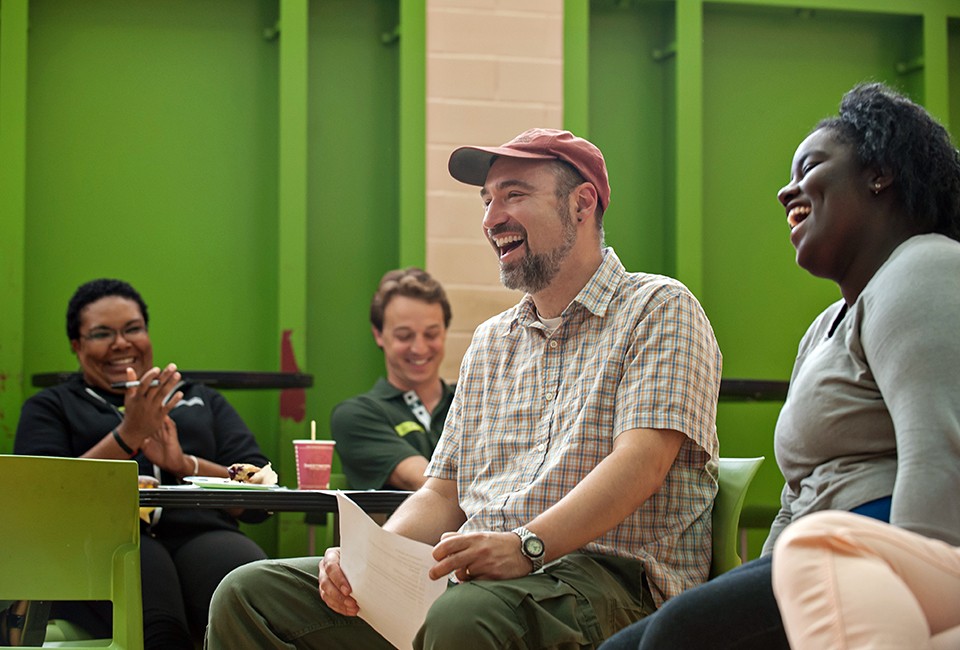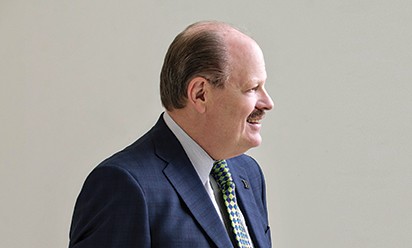Out of the Classroom
Learning comes alive when students engage in place-based education

What’s the first step toward improving a community? Take students out of their classrooms. That’s the premise Ethan Lowenstein, professor of curriculum and instruction, applies to school system reform. As director of the Southeast Michigan Stewardship Coalition (SEMIS), he helps K-12 teachers in partner schools use “place-based” learning experiences to empower students to create positive change in their communities. In recognition of Lowenstein’s work, Michigan Campus Compact, a coalition of college and university presidents, named him 2016 Champion of Engagement. Here, Lowenstein discusses how place-based education is transforming teachers and developing a new generation of innovative problem-solvers.
EASTERN: What is place-based education and how does it differ from traditional teaching?
LOWENSTEIN: Place-based teachers use the relationships students have with their local communities as the starting point and context for learning. The students learn in the real world rather than solely from classroom activities. It’s a very different approach because student questions drive the classes. Teachers, adult mentors and community partners help guide those questions and tie them to a curriculum. When place-based education works well, we see tremendous academic outcomes. Students form strong connections to their community, experience social growth and develop high levels of self-worth.
EASTERN: Can you give an example of a place-based activity within a SEMIS school?
LOWENSTEIN: At the Ann Arbor Learning Community [a K-8 charter school], 4th and 5th graders studied a creek adjacent to the school. They asked questions about the creek, learned about watersheds, and collected water samples and other data as young scientists. Then, by connecting with a local watershed council, they started thinking more deeply about waterways and their surrounding habitats. After more analysis, the students discovered erosion around the creek and invited the water resources commissioner to their class to discuss their findings. The creek is now on an environmental remediation list. This is a powerful example of how community engagement can lead to rigorous academic learning and prepare young people to be active citizens.
EASTERN: Is place-based education interdisciplinary?
LOWENSTEIN: It can apply to any discipline as an entry point. Students learn science, history, math, writing, public speaking, and how to develop presentations in different formats. In a complex world, we need interdisciplinary studies to get at the root of complex problems. Students who connect with their communities in an interdisciplinary way are more prepared to apply solutions to a local crisis because they’ve already thought a great deal about the issue.
EASTERN: Can this educational method inspire young learners to remain in their communities as adults and continue efforts to help them thrive?
LOWENSTEIN: Absolutely. I believe a deep sense of belonging to a community is the primary root of happiness or fulfillment. Place-based education is a holistic kind of learning that allows students to recognize the strengths of their communities, rather than focus solely on what needs to be fixed. When young learners recognize those strengths, they have reasons to stay within their community and find success.
EASTERN: Is place-based education considered an unusual approach to teaching, or is it becoming more mainstream?
LOWENSTEIN: It’s not a novel idea. In the early 1900s, John Dewey advocated using the local community as a context for learning. There were efforts in the early 1990s to create more community-engaged schools, but they disappeared due to an emphasis on standardized testing. Now is the time for place-based education to really emerge. We have more knowledge of place-based teaching methods and more support for teachers using a place-based approach. This isn’t an idealized, pie-in-the-sky teaching philosophy. Place-based education is actually very practical.
EASTERN: Community engagement is one of Eastern’s strategic goals. Is EMU cultivating a place-based approach in students who are preparing to be teachers?
LOWENSTEIN: Place-based education is going to be a strong strand in Eastern’s teacher preparation approach, and SEMIS is a tremendous resource that can help Eastern take its community engagement mission to the next level. We’ve already created a block of classes within SEMIS schools for groups of teaching candidates. Eastern students receive mentoring from place-based teachers and join in the place-based activities the young students create. Our students say they have an increased understanding of the issues the young students face as well as the strengths within those communities. All of this builds upon Eastern’s strong tradition of community engagement. I hope alumni will join us as community partners to help bring this exciting way of teaching and learning to our region and state.
To learn more about the Southeast Michigan Stewardship Coalition, visit semiscoalition.org.
Contact Darcy Gifford, dgiffor2@emich.edu , 734.487.5375

 Charismatic leader takes over as EMU’s president
Charismatic leader takes over as EMU’s president
 Business mogul Aleksandra Efimova lives her college vision
Business mogul Aleksandra Efimova lives her college vision
 Hardly, but today's reporters must master new skills in online universe
Hardly, but today's reporters must master new skills in online universe